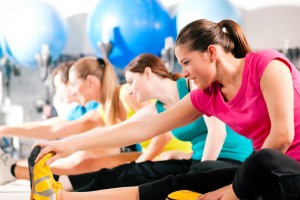
Today’s blog continues our London 2012 Olympic theme and some of the comments in response to our blog on running related musculoskeletal injuries on 1st August. The old adage that ‘prevention is better than cure’ appears to be true according to the results of a systematic review, published in BMC Medicine. The review evaluated the effect of neuromuscular warm-up strategies, that require no additional equipment, for preventing lower limb injuries during sports participation.
Here’s what they did
The authors, from London, searched 7 databases up to January 2012. All 9 studies they included (6 Randomised Controlled Trials and 3 controlled clinical trials) were of moderate quality (assessed with a modified version of the van Tulder scale). Studies included an average of 1,500 participants (range 1,020 to 2,020).
Here’s what they found
- The ’11+ prevention strategy’ significantly reduces overall (RR 0.67, CI 0.54 to 0.84) and overuse (RR 0.45, CI 0.28 to 0.71) lower limb injuries as well as knee (RR 0.48, CI 0.32 to 0.72) injuries among young amateur female footballers.
- The ‘Knee Injury Prevention Program’ (KIPP) significantly reduced the risk of noncontact lower limb (RR 0.5, CI 0.33 to 0.76) and overuse (RR 0.44, CI 0.22 to 0.86) injuries in young amateur female football and basketball players.
- The ‘Prevent Injury and Enhance Performance’ (PEP) strategy reduces the incidence of anterior cruciate ligament (ACL) injuries (RR 0.18, CI 0.08 to 0.42).
- The ‘HarmoKnee’ programme reduces the risk of knee injuries (RR 0.22, CI 0.06 to 0.76) in teenage female footballers.
- The ‘Anterior Knee Pain Prevention Training Programme’ (AKP PTP) significantly reduces the incidence of anterior knee pain (RR 0.27, CI 0.14 to 0.54) in military recruits.
- None of the strategies evaluated were able to produce significant reductions in hip or thigh injuries, or lower leg or ankle injuries.
The Musculoskeletal Elf’s thoughts
 The authors also concluded that the common components of effective neuromuscular warm-up strategies include; stretching, strengthening, balance exercises, sports-specific agility drills and landing techniques applied consistently for longer than three consecutive months. It appears that practical neuromuscular warm-up strategies can reduce lower extremity injury incidence, especially of the knee, in young, amateur, female athletes and male and female military recruits.
The authors also concluded that the common components of effective neuromuscular warm-up strategies include; stretching, strengthening, balance exercises, sports-specific agility drills and landing techniques applied consistently for longer than three consecutive months. It appears that practical neuromuscular warm-up strategies can reduce lower extremity injury incidence, especially of the knee, in young, amateur, female athletes and male and female military recruits.
However our old friend heterogeneity (variability) in study design and warm-up strategies prevented pooling of results. Only two studies investigated male and female participants, while the remaining seven investigated women only. The duration of the prevention strategies ranged from 12 weeks to two years. Furthermore sample sizes were often too small to evaluate specific injury types and methods of recording injury incidence were inconsistent. This makes generalisability of the results difficult. Further studies should also focus on men, other age groups, and other sports. Attention should be given to reporting of adverse effects of, and compliance with, the warm-up strategies.

Common components of effective neuromuscular warm-up strategies include; stretching, strengthening, balance exercises, sports-specific agility drills and landing techniques
In the meantime the Chartered Society of Physiotherapy produce a document on sports specific warm up advice. Alternatively you can see the Scottish tennis player Andy Murray performing a rather unconventional warm up strategy for the Australian Open in 2008 displaying football skills with a tennis ball!
Do you recommend warm-up strategies for sports participation? What is your view on this review, will it change your clinical practice? Send us your views on this blog and become part of the Musculoskeletal Elf community.
Links
- Herman K, Barton C, Malliaras P, Morrissey D. The effectiveness of neuromuscular warm-up strategies, that require no additional equipment, for preventing lower limb injuries during sports participation: a systematic review. BMC Med. 2012 Jul 19;10(1):75. [Epub ahead of print]
- van Tulder M, Furlan A, Bombardier C, Bouter L; Editorial Board of the Cochrane Collaboration Back Review Group.Updated method guidelines for systematic reviews in the Cochrane collaboration back review group.Spine. 2003 Jun 15;28(12):1290-9.
- BBC learning zone Unconventional warm up strategies (flash only) [accessed 30th July 2012]
- Chartered Society of Physiotherapy. Sports specific warm up advice. [accessed 30th July 2012]
- The Cochrane Collaboration Back Group [accessed 30th July 2012]

Thanks for posting and I hope people enjoy the read.
The key driver in this review is wide applicability – these are all interventions that require NO equipment and NO structured training. So every weekend warrior and pub football team could benefit. There are other interventions that can help prevent a wider range of injury and use of equipment and training programmes confers additional benefit – but we felt it really important to focus on the simple approaches. Would welcome people’s thoughts. (BTW – it is an active warm-up and saunas are not part of the recommendations despite the header photo!)
Many thanks for the blog Dylan and could I commend you and your team for publishing it in BMC, an open access journal, so that everyone could benefit from it. I am a bit partial to open access and am sure your university/department might have paid a huge sum as open access is not free (but I am sure the impact factor helps ;) ;)).
From a clinical perspective I was thinking about the compliance issues which you had mentioned. All the participants in the studies that were selected were taking part in group sports such as basketball or football, and the couple of articles which included male and female participants were army recruits, so would train as a regiment/group. The time taken to complete each warm up routine ranges from 15-25 mins, so I was wondering about the compliance for age matched amateur (non-elite) individuals who want to take up sports like tennis, or just long distance running (alone…I know its more fun running as a group ;)).
You did talk about generalasability in your blog and paper however it would be great if you and others could share perspectives on this?
Thank you Tracey, for the post, and Dylan for your comments about your article. I enjoyed reading the article, and despite the stated limitations in external validity it seems we may be wise to take on board your recommendations, ‘that neuromuscular warm-up strategies incorporate stretching, strengthening and balance exercises, sports-specific agility drills and landing techniques, and are completed for a duration of longer than three consecutive months at all training sessions.’ In the absence of good evidence for everyday amateur runners and netballers aged over 26 (actually closer to 40- like myself), I am hoping the recommendations will still help! I am thinking that the recommendations may be more applicable to the under 19’s amateur netball team I coach (although there did not appear to be any netballers in the included trials).